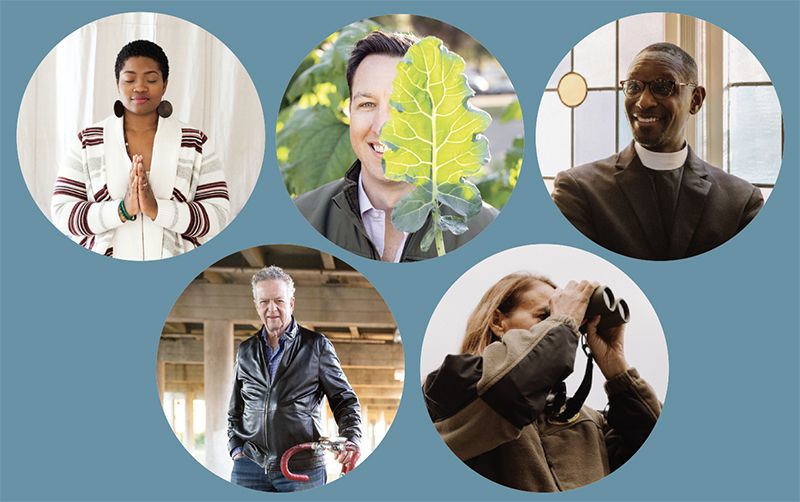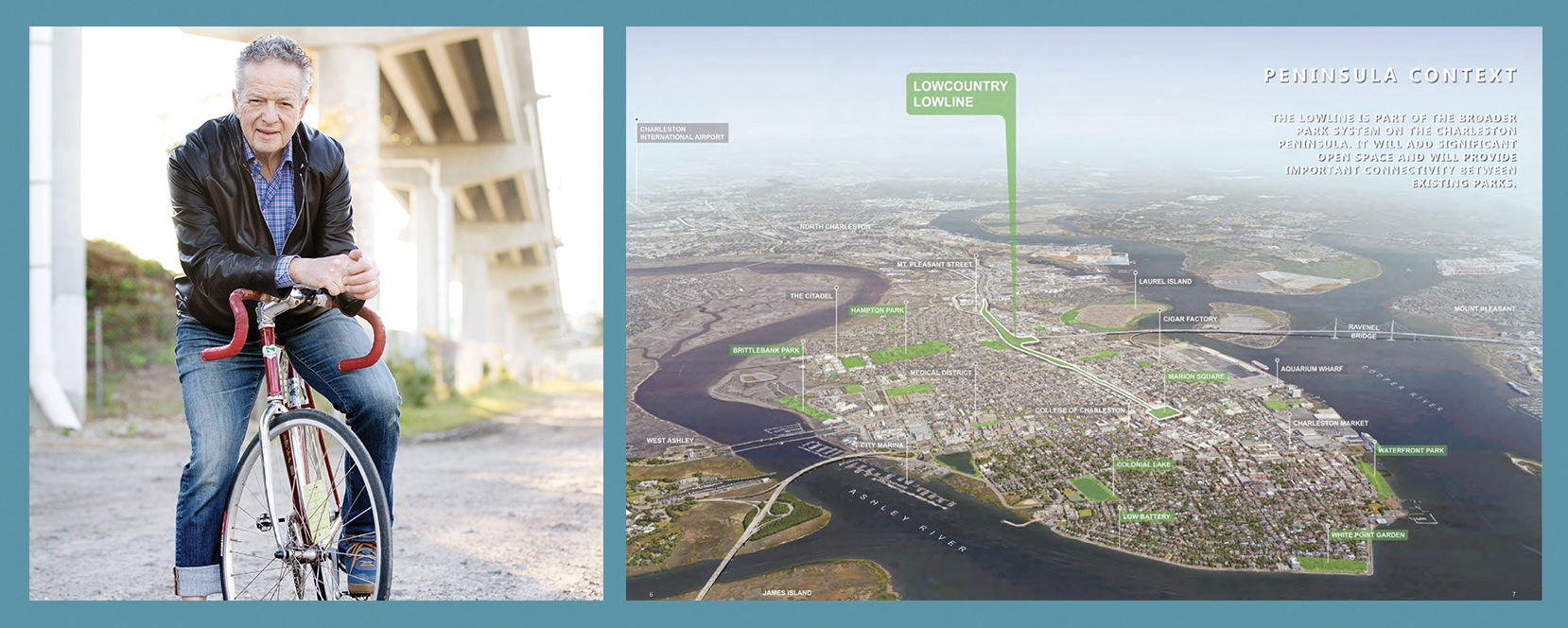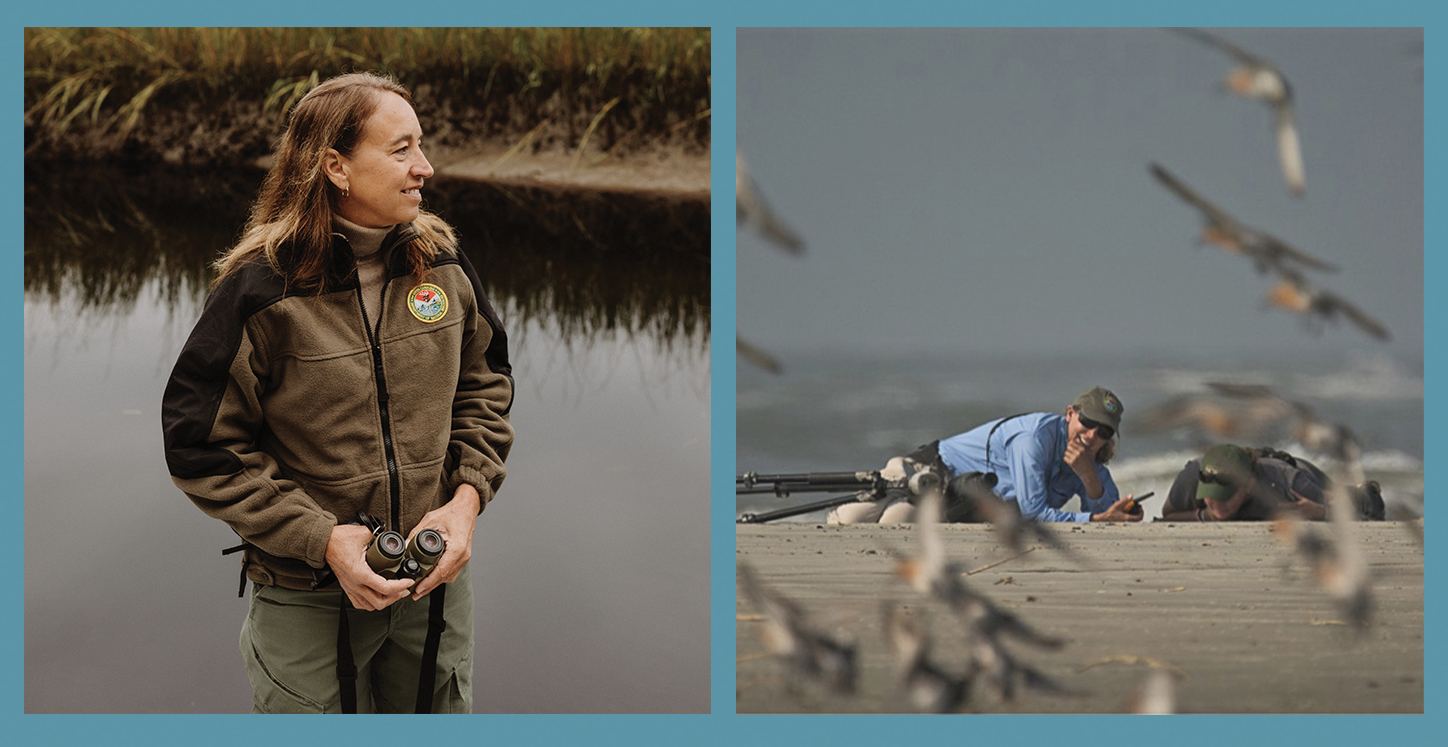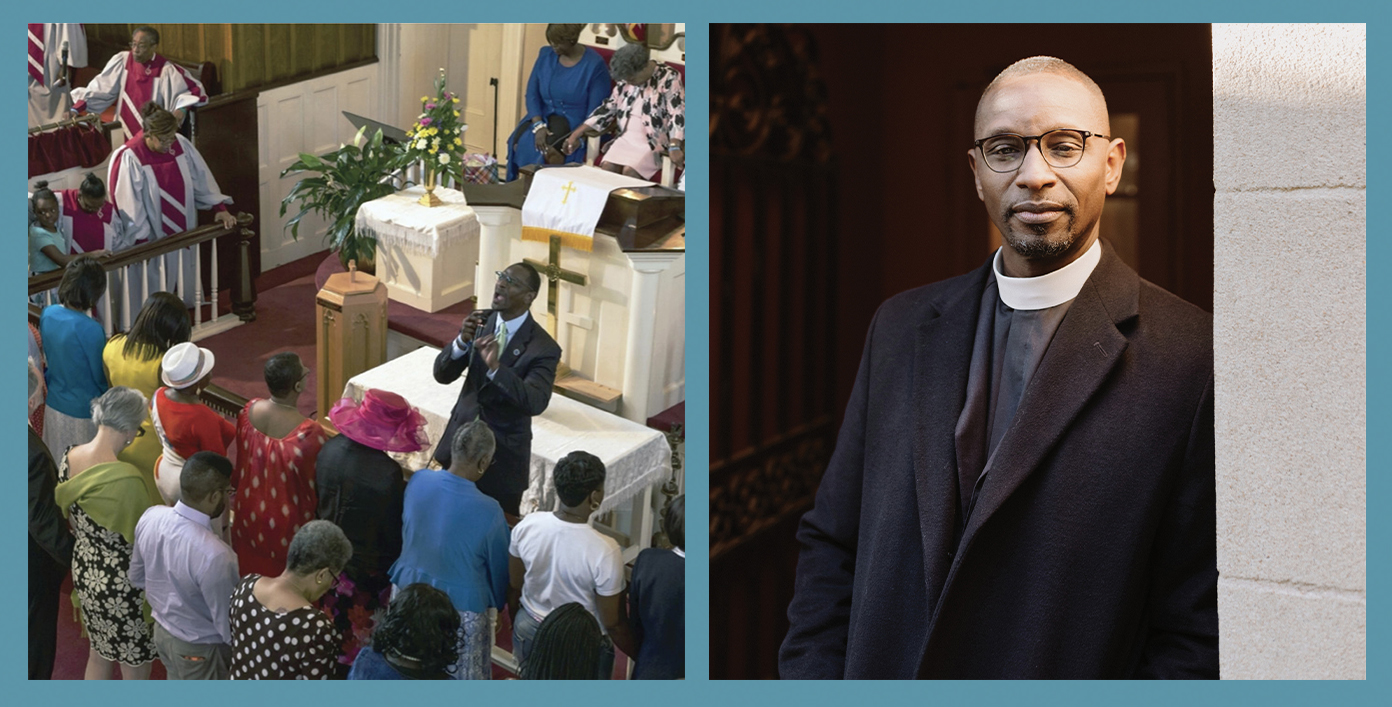Step into 2021 motivated towards health, wellness, the environment, livability, and civic engagement

Meet five locals who can help ignite your inspiration. Each is actively engaged and purposefully making a difference in realms related to health, wellness, the environment, livability, and civic engaement. We applaud their passion and hope you'll be moved by it too.

(Left) Miller leads a class at her studio before the pandemic; (right) Kennae Miller in her sunlight-filled Transformation Yoga studio on King Street.
Kennae Miller - Inspiring healing for all bodies
The first time Kennae Miller took a yoga class in high school, she experienced a calm she’d never known before. “It felt like going from speeding along in six lanes of crazy traffic to just stopping. I was able to center myself for the first time ever,” she says. A self-described “type-A personality,” Miller was then living in Colorado Springs, where she grew up the middle of five children. Her father was an Army veteran and police officer; her mother an oncology nurse; and young Kennae, a spunky, outspoken go-getter.
“I was always involved in school and the community—and always said more than I probably should,” she says of traits that led to her being named one of the Colorado Springs mayor’s 100 Most Influential Teens and granted an NAACP Image Award in 2005. But outward appearance and inner reality don’t always match. Her parents’ marriage was rocky, and her post-high school path uncertain. “Everything was wobbly,” she says. Yoga helped her find steadiness. Despite typically being the only person of color in her classes, she kept practicing.
She practiced through her stint in the Air Force Reserves, where she landed after high school, not wanting to put the financial burden of college on her then-single mother. She kept practicing during the year she worked as a police officer in Macon, Georgia—her brief flirt with following in her father’s footsteps—hoping to make an impact on community justice issues that have always been important to her. She kept practicing after moving to Charleston in 2008 with her then-boyfriend (now husband) Ralph Miller Jr. and working again with the Air Force, as a logistics planner. And through caring for her mother during her terminal bout with breast cancer, and through the birth of her two children 13 months apart.
She kept practicing after her husband was transferred to Hawaii, which was where, in 2015, she finally decided to get her yoga teacher certification. On a retreat prior to her training, Miller was given a word to meditate on: transformation. “And the inner message I kept hearing was, ‘My people need healing.’”
Now, a year after opening Transformation Yoga on King Street, Miller’s footing is steadier than ever. There you’ll find Black, brown, and white bodies, women and men of all shapes and sizes, all identities and abilities, all stretching into themselves. When asked what she does, Miller responds, “I guide people back to themselves through yoga,” a practice that she sees as not about perfecting backbends and headstands, but about liberation, healing, and community. “The word yoga means ‘to yoke, to bring together,’” adds Miller, whose e-mail signature and Instagram bio include, “Ancestor-in-Training,” “Change Invoker,” “Inner Work Instigator.”
Though classes at Transformation Yoga have been strictly virtual since COVID, Miller has doubled-down as a change invoker, particularly in light of this summer’s racial unrest. She’s challenging Charleston’s broader yoga and wellness community to acknowledge where racism shows up in wellness spaces and has hosted “In Agreement” workshops devoted to the work of anti-racism, compassionate accountability, and collective care. On International Womxn’s Day last spring, Transformation Yoga disrupted King Street with rolled-out mats, breath work, and downward dogs taking the place of car traffic. “Liberation is an act of love,” she believes. “Calling people out and calling them in is an act of love. Honoring one’s needs and how they contribute to the collective need is an act of love.”
Miller, who also advocates for food justice as a board member for Fresh Future Farm, continues to honor the practice of self-care, particularly for bodies that hold generational trauma. “Yoga is still teaching me to stay committed to the practice,” she says. “Whether we’re practicing self-care or anti-racism, we fall in and out. No matter what posture we’re in, if we can ground ourselves, come back to feeling our hearts and our breaths in this moment, then we’re doing the best we can.”

(Left) On Instagram (@theguthealthmd), Dr. Will Bulsiewicz shares recipes and entertaining posts on the benefits of “eating the rainbow.” (Right) Dr. B among the sunflower stalks at The Green Heart Project’s urban farm on King Street
Will Bulsiewicz, MD - Inspiring a healthier you
If you’re among the multitudes who include “lose weight” or “get healthier” as a New Year’s goal, then Dr. Will Bulsiewicz has two words to inspire you: gut microbiome.
“The greatest determinant of your health during your lifetime is the food you eat,” he writes in his debut book, Fiber Fueled (Penguin Random House), published last May. According to Bulsiewicz, “diversity of plants” in your diet is the Golden Rule of health, and abiding by it will lead to healthy, robust gut microbes, which in turn affect everything from mood to weight to cognitive clarity to a strong immune system, and that’s just for starters.
Known as “Dr. B” to his patients, or “the Gut Doctor” to his legion of social media followers, Bulsiewicz is a local gastroenterologist who has an uncanny way of chewing through all the blather about fad diets, superfood-this and paleo-that and dishing up straight talk about the benefits of plant-based eating. He’s equal parts footnote-happy scientist; dedicated physician; fiber evangelist; Mount Pleasant husband and dad; and as of this summer, New York Times best-selling author. “I’m a doctor. My day job is dedicated to helping heal people. It’s a great honor that I value,” he says. “My book and social media are an extension of that. They give me the ability to connect with more people interested in changing their lives.”
In terms of changing lives, his is case study number one. He was once 50 pounds overweight, a hot dog connoisseur who felt exhausted and much older than his 32 years, at the time. Despite being a high achiever—he excelled in medical school and was a chief resident at one of the country’s top gastroenterology programs—“I was miserable,” he says. “I had low self-confidence and anxiety. I thought I could exercise my way out of it.”
When that failed, he began observing how his new bride, Valarie, a vegetarian, ate basically whatever she wanted without worrying about her weight. After slowly shifting his meat-heavy habits to more fruits, nuts, vegetables, legumes, and whole grains, he observed a gradual change in how he looked and felt, dropping that extra 50 and returning to his college weight. Meanwhile, new science was revealing the relationship between diet and gut bacteria, or “microbiota.”
“We knew next to nothing about the microbiome in 2010,” he says, but study after study now affirms how fiber from plant-based foods can restore gut health and remedy the myriad health issues he sees on a daily basis, from irritable bowel to leaky gut to depression and heart disease. Dr. B, who moved to Charleston in 2016, slowly began encouraging his patients to shift to more plant-based foods (he’s not a zealot—aiming for 80 to 90 percent of your diet would be ideal, he suggests), and saw transformation. “But it was a small part of what I did,” he says. That is until Roper St. Francis Healthcare invited him to give two talks, and both drew standing-room only crowds. Then, in 2017, The Post and Courier featured him in an article on the benefits of fermented foods, “and my phone started buzzing. People had questions. I realized that there was a much bigger audience.” His book proposal garnered a New York publishing house bidding war, and Fiber Fueled sold 80,000 copies in six months.
Now a sought-after podcast guest and social media star, Dr. B is enjoying the publicity glow, but he remains first and foremost a frontline doctor, performing colonoscopies and treating intestinal diseases. His mission is your health. “You don’t reverse disease with a pill. Diet and lifestyle is how you do that,” he says. “I’m a translator; we’re learning more every day about how the immune system is connected to the gut. The pandemic, which most severely impacts people with metabolic disease, shows us that now, more than ever, is the time to transform our health through diet and lifestyle.”
Dr. B’s Favorite Fiber-Fueled Foods, or “F GOALS”
Fiber Fueled explains why “eating the rainbow” (i.e. a colorful array of diverse plants) is far healthier than the Standard American Diet and includes menus and recipes for a four-week Fiber Fueled plan. Here is his abbreviated guide of F GOALS for optimizing gut health:
F - Fruit & Fermented
G - Greens & Grains
O - Omega-3 Super Seeds
A - Aromatics (onions, garlic)
L - Legumes
S - Sulforaphane (broccoli sprouts and other cruciferous vegetables)

(Left) Friends of the Lowcountry Lowline board chair Tom Bradford at a section of the proposed linear park; (right) The Lowcountry Lowline will be a two-mile-long linear park connecting neighborhoods from Mount Pleasant Street to Marion Square.
Tom Bradford - Insipring livability through inclusive places
As a former CBS News executive in New York, Tom Bradford was a pro at producing the news. In fact, in the early 1990s, he created one of the first overnight news shows, helping pave the way for our current 24/7 cable news regimen. Today, as a civic champion in Charleston, he’s making news, by paving dynamic and innovative ways for moving around our region.
Bradford is the kind of guy who goes bumping over old railroad tracks, but rather than letting shock absorbers mute the disruption, he lets it rattle his brain a bit, jostle his creativity. He looks southward where those old tracks at the intersection of Mount Pleasant, Meeting, and Upper King streets lead to a weed-choked, litter-strewn abandoned alley. There, he sees potential—green space, an urban park, a new bikeway and pedestrian route leading to the heart of the peninsula.
That’s the vision for The Lowcountry Lowline, the livability improvement project that Bradford, as chair of the Friends of the Lowline board of directors, is helping steer toward reality. In collaboration with Michael Messner, whose Speedwell Foundation has been a major funder, Bradford has rallied political support and worked with Scott Parker of Design Works to develop a conceptual master plan for the two-mile-long linear park. The city enthusiastically supports the concept and secured a long-term lease from the SC Department of Transportation to add more land to the now 40-acre endeavor.
“The plans take my breath away, really. I love that the Lowline will bridge eight different neighborhoods, creating a conduit linking them and moving people through, from predominantly Black neighborhoods to predominantly white ones,” says Bradford, a “preacher’s kid” who grew up in Pennsylvania and went to college in Michigan. When he and his wife, Susan Bass, were looking to relocate from New York, they were drawn to Charleston’s three “Cs”—“culture, climate, and cost.” Once here, both quickly dove into various civic engagements, including birthing the Lowline, which has topped Bradford’s agenda for nearly a decade.
An avid cyclist, Bradford honed his vision for enhanced mobility and connectivity, which the Lowline will provide, through his years working with Charleston Moves, first as interim acting director and then board chair. When Bradford got involved in 2006, the nonprofit was a fledgling bicycling advocacy group born out of efforts to win a bike/pedestrian lane on the Ravenel Bridge. Bradford soon went from weekend cyclist to City Hall regular. “Charleston Moves got me engaged in the conversation on livability and smart urban design. It’s also how I met Mike Messner,” says Bradford, who served on the mayor’s Peninsula Advisory Task Force, helped start Second Sundays on King Street, and is part of the Livability PAC.
The Lowline will be a unique and, as Bradford believes, game-changing asset. Unlike Marion Square or Hampton Park, which are contained, the Lowline is designed as connective tissue, enhancing mobility with separate walking and bicycling paths from Mount Pleasant Street to Marion Square, as well as an array of recreation, arts, and passive-use areas, as it traverses the peninsula below I-26, an interstate that scarred once healthy, diverse neighborhoods. “As I told Mayor Tecklenburg, this is an opportunity for equity and inclusion, a clear and tangible way to mend neighborhoods the interstate had torn apart and reframe the racial dialogue. The Lowline presents a wide-open vision for what the future of Charleston can be.”
The Lowline’s Four Core Principles for Resilience
● Social: Alternative transportation promotes equity; parks encourage social gathering
● Environmental: Designed to store water runoff; adds green space; promotes health and wellness
● Cultural: Combats displacement of residents by strengthening local neighborhoods
● Economic: Creates value in the urban core and provides opportunities for local businesses

(Left) Felicia Sanders’s work has helped earn designation for five coastal island seabird sanctuaries in South Carolina. In October, she was named the Southeastern Association of Fish and Wildlife Agencies’s 2020 Wildlife Biologist of the Year; (right) Sanders banding red knots on Seabrook Island.
Felicia Sanders - Inspiring conservation (and shorebird love)
You’ve seen them, the tiny birds that rapid-fire tiptoe at the surf’s edge—sandpipers and plovers, whimbrels and willets that dance and prance so lightly that it’s hard to imagine how such a delicate creature can move so fast. But biologist Felicia Sanders does more than marvel, she worries. After 20 years of studying their migratory habits and surveying their populations along our coast, she knows our shorebirds are threatened by human encroachment and coastal development, which is why she’s inspired to protect them.
As the Coastal Bird Conservation Project Supervisor for the South Carolina Department of Natural Resources (SCDNR), Sanders monitors our seabird and migrating shorebird populations—some 33 species of winged wonder. “I always wanted to be a wildlife biologist,” says the Georgia native, who grew up loving the outdoors, studied biology at Duke University, and solidified her trajectory after an internship on a wildlife ranch in Africa. “Kenya gave me an incredible opportunity to see the need for wildlife biology and conservation and what an amazing career it could be,” she explains. After returning to the States, Sanders spent 11 years working with the US Forest Service in Florida, studying the red-cockaded woodpecker and other birds, before returning to graduate school.
“Working on field projects was fun, but I realized I wanted to have more of a say in conservation in order to make a greater impact on the birds I’d fallen in love with,” says Sanders. She earned her masters in wildlife and fisheries biology from Clemson, landed her “dream job” at SCDNR after graduating in 2001, and has been headquartered at the Santee Coastal Reserve, not far from her home in McClellanville, ever since. “Over time, I realized we really needed to focus on seabirds and shorebirds—those little guys that wade on the beach and pick at the sand and mud. Both groups are strictly coastal with a very narrow habitat, which also happens to be where everyone across the country and world wants to be. We’re squeezing them,” notes Sanders.
Her work has entailed surveying and documenting species, including the American oystercatcher, finding that half of the wintering population along the Atlantic coast is here in South Carolina. She’s tracked red knots, “putting South Carolina on the map as critical for that species,” she says, after discovering that our coast is some knots’ only pit stop en route to the Arctic, where she’s also gone to study shorebird nesting habits over five summers. “To get there, I had to take a big plane, then a little plane, then a helicopter. Meanwhile, I look out the window and realize a tiny bird is making that same trip, flying all that way.”
Last October, Sanders was named the Southeastern Association of Fish and Wildlife Agencies’s 2020 Wildlife Biologist of the Year, recognizing her accomplishments that include getting designation for five coastal island seabird sanctuaries, as well as the Cape Romain-Santee Delta Region as a Western Hemisphere Shorebird Reserve Network Site of International Importance. “I was completely shocked,” she says of winning an award that typically goes to more senior DNR directors. “It speaks to the importance of our work and gives the shorebirds more attention,” continues Sanders, who manages a team of five women biologists. Recent triumphs include a successful collaborative campaign to protect critical pelican nesting areas at Crab Bank. “It gave me hope seeing how many people and organizations came together. I thought I was the only person crazy about these birds.”
Sanders is currently studying a large concentration of whimbrels, a curlew species of high conservation concern, at Deveaux Bank. “They’re really declining, so we need to take a closer look at them,” she says. Meanwhile, she’s constantly educating the public on how human disturbance is detrimental to shorebird populations. “The average person walking down the beach may not pay much attention to a flock of birds, but if they realize these creatures just landed after flying all the way from Brazil, then maybe they’ll let them rest and feed, or keep their dogs from chasing them and obey leash laws,” she says. “Something so simple might help these birds make it around the hemisphere.”
Top 5 Declining Shorebirds in the Lowcountry
● Red knot
● Piping plover
● Whimbrel
● Semipalmated sandpiper
● Wilson’s plover

(Left) Middleton leads a Sunday morning worship service pre-COVID; (right) The Reverend Dr. Kylon Middleton at Mount Zion AME Church on Glebe Street, where he serves as senior pastor.
Kylon Middleton - Inspiring leadership
No one has ever called The Reverend Dr. Kylon Middleton a slacker. The senior pastor of Mount Zion AME Church in downtown Charleston is 48 years old, and he’s been in ministry the majority of those years. “I started exhorting—you know, low-budget preaching—at age eight, was first licensed when I was 13, then ordained at 15. I don’t ever remember a time when I was not fully immersed in ministry,” says the Charleston native, who graduated from Burke High School at age 15, had his own church in North Charleston a year later, and completed a double major in English and communications from the College of Charleston by 18. When he taught 12th grade English at Burke shortly thereafter, he wasn’t much older than his students. “That was an interesting experience; it caused me to grow up real fast,” notes Middleton, who went on to earn advanced degrees in education and theology from Lutheran Theological Southern Seminary in Columbia, the University of North Carolina, and Duke.
Fast is Middleton’s operative mode. He’s a man of faith and a man of action. If you’re interested in dialogue and mulling things over, he’ll gladly listen—for a bit—but mostly he’s a down-to-business, get-it-done guy, especially when it comes to social justice. “I’ve always been a maverick, one who pushed against the status quo of the day. I was the kid righting wrongs on the playground, kicking against any discrimination or intentional marginalization of people. It’s in my DNA, in my character,” he says.
Middleton traces that DNA to his parents and his maternal grandmother, Nazarene Baldwin Graham, his family’s “bedrock.” She, too, was deeply spiritual, becoming an AME minister (as was her father) at a time when women were not allowed. “But she went anyway,” Middleton says. She was also one of the first Black women to own a local restaurant, Naz’s Dinet, described in her obituary as “a place where people of all races…could feast on soul food cuisine in an atmosphere that honored their dignity, where everyone was respected as human beings.” She set a formative example for her grandson. “She was trying to exercise her calling in a system that did not welcome that. Instead of leaving, she stayed and transformed that system. And that transformed my mind-set,” he reflects.
Fast forward to 2021, and Middleton is looking to transform local government after he’s sworn in as a Charleston County Councilman this month. He’s vowed to bring more transparency to County Council’s dealings and to make sure local government is responsible to all citizens. “My ministry calls me to public work; the prophetic voice extends to the world,” he explains. “I ran for office on a platform of strong moral leadership, because somewhere along the line, being ethical went out the window.”
He chose to run for County Council rather than for a Statehouse or Congressional seat because he’s a firm believer in the axiom that all politics is local. Plus, he points out, Charleston County Council “is a powerful government entity with almost a half-billion-dollar budget. The policies it enacts affect our everyday lives. The change I want to see is right here, in our community. I’m a pastor, and this is my parish.”
Though this is Middleton’s first foray into public office, it is hardly his debut as a public figure. Since arriving back in Charleston six years ago, right after the Emanuel AME Church shootings (his closest friend was Clementa Pinckney), Middleton has been front and center in community dialogues, protests, and various justice-related endeavors. He is active with the Social Justice Racial Equity Collaborative hosted by the Sophia Institute, which authored the apology for slavery passed by the City of Charleston. He works with the Racial Equity Institute at the YWCA and the Charleston Area Justice Ministry, serves on the City’s Housing Commission, and led the Illumination Project. Every Tuesday evening, he co-leads a book study hosted by Mount Zion and its predominantly white neighboring congregation, Grace Church Cathedral, that’s been going strong for five years, tackling challenging texts dealing with racial reconciliation.
“It’s a wonderful time to be a leader in Charleston, an opportunity to right the wrongs of our founding past,” says Middleton, who wakes up early every day and hits the gym, powering up to be a change agent. “I don’t want to be on the sidelines; I need to be in the game. I feel the weight of this moment—it’s urgent, it’s necessary. I was called to teach, called to preach, and I believe I’m called in this season to be a transformational leader in this community.”
County Councilman Middleton’s Initial Areas of Focus
● Affordable, attainable housing
● Equitable allotment of COVID-19 relief and vaccines
● Infrastructure and flooding relief and speaking up for communities without “power dynamics behind them,” such as the Phillips Community at risk with the proposed widening of Highway 41